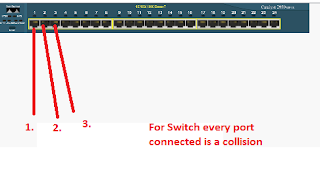Problem 1
Identifying Collision and broadcast domain.
In the following exhibit, identify the number of collision domains and broadcast domains in each specifies device. Each device is represented by a letter:
A. Hub
B. Bridge
C. Switch
D. Router
A. (Hub)
Diagram 1
Ans: BoardCast Domain : 1
Collision Domain : 1
Diagram 2
BoardCast Domain : 1
Collision Domain : 1
Diagram 3
Note: Entire Hub is a collision Domain.
Without a router connected, broadcast Domain will away remain as 1
BoardCast Domain : 1
Collision Domain : 1
B. (Bridge)
Diagram 1
Note: Entire Hub is a collision Domain.
BoardCast Domain : 1
Collision Domain : 2
C. (Switch)
Diagram 1
Note: every port used on the switch is a collision
Ans: BoardCast Domain : 1
Collision Domain : 3
Diagram 2
Note: 3 PC connected to the switch created 3 collision and entire hub connected to the switch belong to 1 single collision
BoardCast Domain : 1
Collision Domain : 4
D. (Router)
Diagram 1
*Router do not allow Broadcast domain and multicast to go through!
* Without a router connected, broadcast Domain will away remain as 1 but with router , it have created 3 broadcast domain. Every port used on the router create a broadcast domain. Note: Entire Hub is a collision Domain.
BoardCast Domain : 3
Collision Domain : 3
Diagram 2
For switch ,every port that is been used is a collision domain. Switch and Hub connected to the router have created two more collision domain. Note: Entire Hub is a collision Domain.
BoardCast Domain : 2
Collision Domain : 5
Diagram 3
BoardCast Domain : 2
Collision Domain : 7
Problem 2
Convert the following from binary format to decimal IP adddress.
Complete the following table to express 11001100.00110011.10101010.01010101 in decimal IP address format.
128 64 32 16 8 4 2 1 Decimal
Working:
128
|
32
|
128
|
64
|
||||
64
|
16
|
32
|
16
|
||||
+ 8
|
+ 2
|
+ 8
|
+ 4
|
||||
4
|
1
|
2
|
1
|
||||
______
|
______
|
______
|
______
|
||||
204
|
51
|
170
|
85
|
Ans: 204.51.170.85
Convert from decimal IP address to binary format.
Complete the following table to express 192.168.10.15 in binary format.
128 64 32 16 8 4 2 1 Decimal
Working:
192(base10) = 1100 0000 (base 2)
168(base10) = 1010 1000 (base 2)
10 (base10) = 0000 1010 (base 2)
15 (base10) = 0000 1111 (base 2)
Ans: 1100 0000. 1010 1000. 0000 1010. 0000 1111
Problem 3
Given the following IP address and subnet mask determine thier respective Network ID and HostID
1) 212.100.200.123
255.255.255.0
Ans:
Network ID
|
Host ID
|
|||
212.
|
100.
|
200.
|
123
|
|
AND
|
255.
|
255.
|
255.
|
0
|
Net ID
|
212.
|
100.
|
200.
|
0
|
Host ID
|
0.
|
0.
|
0.
|
123
|
Step 2: in order to get Net ID we use 212 and AND (logic gates) with 255.
255 in binary code is 1111 1111(base 2) and 212 in binary code will be 11010100 (base 2). note: if you can remember clearly everything multiply with 255 will result in same number.
1101 0100
x 1111
1111
1101
0100
Then do the same on the rest at only Network ID .
Network ID
| ||||
212.
|
100.
|
200.
| ||
AND
|
255.
|
255.
|
255.
| |
Net ID
|
212.
|
100.
|
200.
| |
Do take note not to multiply anything on the Host ID portion , i know 123 AND with 0 will result in zero. But to get the Net ID you only do multiply on Network ID portion and the rest will be just zero.
Network ID
|
Host ID
| |||
212.
|
100.
|
200.
|
123
| |
AND
|
255.
|
255.
|
255.
|
0
|
Net ID
|
212.
|
100.
|
200.
|
0←
|
Network ID
| ||||
212.
|
100.
|
200.
| ||
AND
|
255.
|
255.
|
255.
| |
Host ID
|
0.
|
0.
|
0.
|
then on the Host ID portion you just copy everything down or i can simply say it you OR (logic gates) it. 123 + 0 = 123.
Network ID
|
Host ID
| |||
212.
|
100.
|
200.
|
123
| |
AND
|
255.
|
255.
|
255.
|
0
|
Host ID
|
0.
|
0.
|
0.
|
123←
|
2)183.6.45.124
255.255.0.0
Network ID
|
Host ID
|
|||
183.
|
6.
|
45.
|
124
|
|
255.
|
255.
|
0.
|
0
|
|
Net ID
|
183.
|
6.
|
0.
|
0
|
Host ID
|
0.
|
0.
|
45.
|
124
|
3} 12.205.3.224
255.0.0.0
Network ID
|
Host ID
|
|||
12.
|
205.
|
3.
|
224
|
|
255.
|
0.
|
0.
|
0
|
|
Net ID
|
12.
|
0.
|
0.
|
0
|
Host ID
|
0.
|
205.
|
3.
|
224
|
















